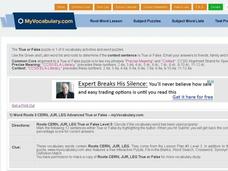Have Fun Teaching
Context Clues (5)
Unfamiliar words can make it difficult to understand what a piece of writing is trying to say. Practice using context clues to define words you don't know with a language arts worksheet, which features five sentences and enough space to...
K12 Reader
Context Clues: The Meaning Is There!
Learning how to use context clues is helpful for both reading comprehension skills and to determine the meaning of unfamiliar vocabulary words. As they read ten sentences with underlined words, learners choose the most...
Prestwick House
Vocabulary Activity Sheet
What does it mean to stream a program? How do you know if you're watching a mash-up? If you don't know these words, reach for your handy Merriam-Webster dictionary, because they're there! A series of fill-in-the-blank questions...
K12 Reader
Determine the Meaning
Enhance elementary readers' vocabulary skills with a worksheet focused on context clues. Individuals read ten short sentences, each with an underlined word, and look over four options to find the most appropriate synonym that could...
Curated OER
Vocabulary in Context: Test Yourself with the New York Times
Drawn from the New York Times' superb Learning Network program, this multiple choice question checks readers' knowledge of two vocabulary words in a paragraph from a review of the 2011 film Take Shelter. An interactive answer key clearly...
Curated OER
Word Roots 5: Nat, Tract, Sequ Beginner Fill-in-the-Blank
Ask your class to complete this activity to help them develop their vocabulary. Learners are given a word bank, word root information, and a series of 12 sentences to complete using the given words. They must use context clues and any...
Curated OER
Word Roots 2: Fin, Sed, Fer Beginner True and False 1
Emphasize proper usage of vocabulary words with this online activity. Class members read each sentence and use context clues to determine if each word has been used correctly or incorrectly. The resource provides a word list and...
Curated OER
Word Roots 4: Grad, Mot, Cad Advanced True and False 3
Test your pupils' vocabulary skills with this somewhat unconventional activity. Using context clues and word roots, leaners must decide whether a word is used correctly in a sentence or if it is not. This is a true/false activity; if the...
Curated OER
Word Roots 7: SPECT, STA, VERT Advanced Fill-in-the-Blanks
Looking for a solid vocabulary exercise? This one might be for you! For this activity, learners fill in 12 blanks using context clues, word roots, and a word bank. They can receive instant feedback, since this resource is online and...
Curated OER
Word Roots 4: Grad, Mot, Cad Beginner Fill-in-the-Blanks
Using context clues and learning root words are two great ways to improve vocabulary. This resource taps into both of those strategies, offering up 12 fill-in-the-blank sentences, a word bank, and information on Latin roots. You might go...
LearnEnglishFeelGood.com
Participles Used As Adjectives
Is a movie interesting or interested? Use context clues to decide which participle would be the most appropriate in each of ten sentences.
K12 Reader
Using Antonyms for Context Clues
Readers use the antonyms provided within a sentence to help them determine the meaning of underlined words in the sentence. The worksheet is the final resource in a series that provides opportunities to kids to demonstrate their...
Curated OER
Gap Filling 4: Context Clues
Help your English learners strengthen their use of context clues in this straightforward worksheet. Twenty questions provide learners with multiple choices for completing several sentences. They choose the option that has the correct...
Teach-nology
Being a Comedian Isn’t All Laughs
What's it like to be a comedian? Find out with a short cloze passage about the life of a comedian. Kids use eight words at the bottom of the page to fill in the blanks throughout the passage.
K12 Reader
Understanding the Context: The Mayflower Compact
Scholars obtain a brief background of the Mayflower Compact, read its contents, and answer two questions that look at the passage's context to enhance reading comprehension.
Curated OER
Lie & Lay
When do you use "lie," and when do you use "lay"? Use this worksheet in your ESL class to find the difference. Ten questions provide sentences with blanks for English learners to complete with the two verbs, often in different tenses....
Curated OER
Word Roots 5: NAT, TRACT, SEQU Fill-in-the-Blanks Advanced
Explore word roots with this online resource. Learners fill in twelve blanks using a provided word bank and context clues. Since this is an online resource, participants can receive immediate feedback for their responses. You might use...
Curated OER
Word Roots 7: Spect, Sta, Vert Intermediate Fill-in-the-Blanks
Using a word bank and context clues, scholars fill in the blanks in 12 sentences. This resource is slightly unique because of the focus on word roots. There is information about each root involved in the activity on the webpage. Also,...
Curated OER
Word Roots CERN, JUR, and LEG Advanced True/False Quiz
An above-average vocabulary test: given a vocabulary word in the context of a sentence, pupils must decide, using their knowledge of the word's meaning along with context clues, if the word is used correctly or not. This worksheet...
Curated OER
So & So That
When do you use "so" or "so that"? Practice this skill with your ESL students in this worksheet, which includes twenty multiple-choice questions. Each question prompts English learners to choose the correct way to complete the...
K12 Reader
Using Inference in Writing
What could have happened to a plane buried in snow? Have kids practice making inferences with a writing prompt for which they describe a photo without using specific key words.
LearnEnglishFeelGood.com
Simple Present or Present Continuous?
Mastering verb tense is an important part of building your learners' reading skills. Young grammarians look over ten sentences and use context clues to decide whether they should use the present or present progressive tense.
K12 Reader
Earthquakes: Movement of the Earth's Crust
Readers use context to determine the meaning of words found in a short article about earthquakes and the movement of the earth's crust.
Have Fun Teaching
When Am I? (16)
How can you tell when a story takes place? Use context clues to infer the time of day and seasons of five short reading passages. Kids then note each passage's time period as daytime or nighttime, as well as winter or summer.

























